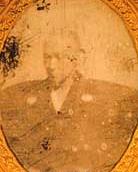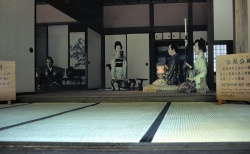Difference between revisions of "Daimyo"
| Line 15: | Line 15: | ||
The [[Onin War]] was a major uprising in which shugo daimyo fought each other. During this and other wars of the time, ''kuni [[Ikko-ikki|ikki]],'' or provincial uprisings, took place as locally powerful warriors sought independence from the shugo daimyo. The deputies of the shugo daimyo, living in the provinces, seized the opportunity to strengthen their position. At the end of the fifteenth century, those shugo daimyo who succeeded remained in power. Those who had failed to exert control over their deputies fell from power and were replaced by a new class, the "sengoku daimyo," who arose from the ranks of the ''shugodai'' and ''[[Ji-samurai|kokujin]].'' | The [[Onin War]] was a major uprising in which shugo daimyo fought each other. During this and other wars of the time, ''kuni [[Ikko-ikki|ikki]],'' or provincial uprisings, took place as locally powerful warriors sought independence from the shugo daimyo. The deputies of the shugo daimyo, living in the provinces, seized the opportunity to strengthen their position. At the end of the fifteenth century, those shugo daimyo who succeeded remained in power. Those who had failed to exert control over their deputies fell from power and were replaced by a new class, the "sengoku daimyo," who arose from the ranks of the ''shugodai'' and ''[[Ji-samurai|kokujin]].'' | ||
| + | |||
| + | ==Sengoku daimyo== | ||
| + | Among the sengoku daimyo 戦国大名 were many who had been shugo daimyo, such as the [[Satake clan|Satake]], [[Imagawa clan|Imagawa]], [[Takeda clan|Takeda]], [[Toki clan|Toki]], [[Rokkaku clan|Rokkaku]], [[Ouchi family|Ouchi]], and [[Shimazu family|Shimazu]]. New to the ranks of daimyo were the [[Asakura clan|Asakura]], [[Amago clan|Amago]], [[Nagao clan|Nagao]], [[Miyoshi clan|Miyoshi]], [[Chosokabe clan|Chosokabe]], [[Jimbo clan|Jimbo]], [[Hatano clan|Hatano]], [[Oda clan|Oda]], and [[Matsunaga clan|Matsunaga]]. These came from the ranks of the ''shugodai'' and their deputies. Additional sengoku daimyo such as the [[Mori clan|Mori]], [[Tamura clan|Tamura]], and [[Ryuzoji clan|Ryuzoji]] arose from the ''kokujin.'' The lower officials of the shogunate and [[ronin]] ([[Late Hojo clan|Late Hojo]], [[Saito clan|Saito]]), [[Kokushi (official)|provincial officials]] ([[Kitabatake clan|Kitabatake]]), and ''[[kuge]]'' ([[Tosa Ichijo clan|Tosa Ichijo]]) also gave rise to sengoku daimyo. | ||
Revision as of 11:10, 23 January 2011

The daimyo大名 were the most powerful feudal rulers from the 10th century to the early 19th century in Japan following the Shogun. Though the term "daimyo" literally means "great name," the Japanese word actually comes from the words dai, meaning "large," and myo (shortened from myoden) meaning "name-land" or "private land." From the shugo of the Muromachi period through the sengoku to the daimyo of the Edo period, the rank had a long and varied history. The term "daimyo" is also sometimes used to refer to the leading figures of such clans, also called "lord". It was usually, though not exclusively, from these warlords that a shogun arose or a regent was chosen.
The daimyo usually wore purples, ranging from dark to light depending on how high ranked they were. Dark and light purple preceded dark and light green, dark and light red, and finally black. The very highest daimyo were considered to be nobles.
Shugo daimyo
The shugo daimyo 守護大名 were the first group of men to hold the title "daimyo." They arose from among the shugo during the Muromachi period. The shugo daimyo held not only military and police powers, but also economic power within a province. They accumulated these powers throughout the first decades of the Muromachi period.

Major shugo daimyo came from the Shiba, Hatakeyama, and Hosokawa clans, as well as the tozama clans of Yamana, Ōuchi, and Akamatsu.The greatest ruled multiple provinces.
The Ashikaga shogunate required the shugo daimyo to reside in Kyoto, so they appointed relatives or retainers, called shugodai, to represent them in their home provinces. Eventually some of these in turn came to reside in Kyoto, appointing deputies in the provinces.
The Onin War was a major uprising in which shugo daimyo fought each other. During this and other wars of the time, kuni ikki, or provincial uprisings, took place as locally powerful warriors sought independence from the shugo daimyo. The deputies of the shugo daimyo, living in the provinces, seized the opportunity to strengthen their position. At the end of the fifteenth century, those shugo daimyo who succeeded remained in power. Those who had failed to exert control over their deputies fell from power and were replaced by a new class, the "sengoku daimyo," who arose from the ranks of the shugodai and kokujin.
Sengoku daimyo
Among the sengoku daimyo 戦国大名 were many who had been shugo daimyo, such as the Satake, Imagawa, Takeda, Toki, Rokkaku, Ouchi, and Shimazu. New to the ranks of daimyo were the Asakura, Amago, Nagao, Miyoshi, Chosokabe, Jimbo, Hatano, Oda, and Matsunaga. These came from the ranks of the shugodai and their deputies. Additional sengoku daimyo such as the Mori, Tamura, and Ryuzoji arose from the kokujin. The lower officials of the shogunate and ronin (Late Hojo, Saito), provincial officials (Kitabatake), and kuge (Tosa Ichijo) also gave rise to sengoku daimyo.